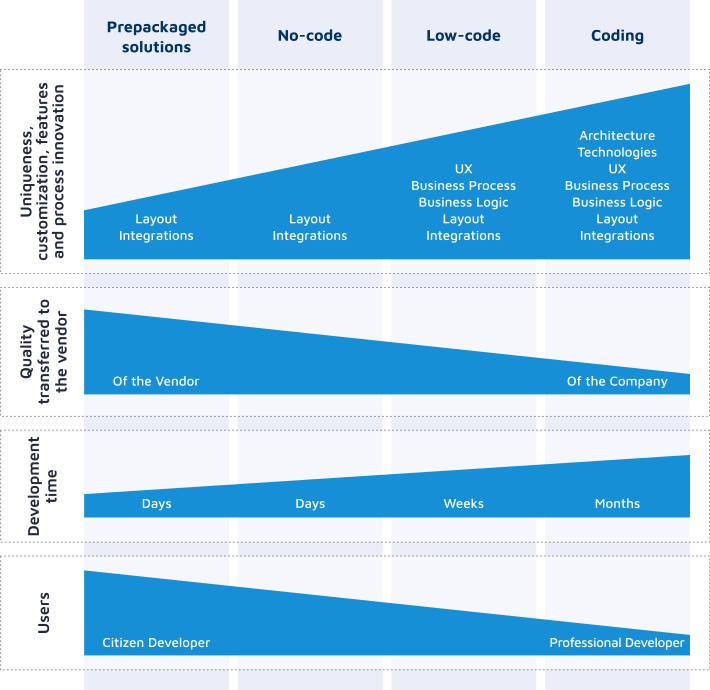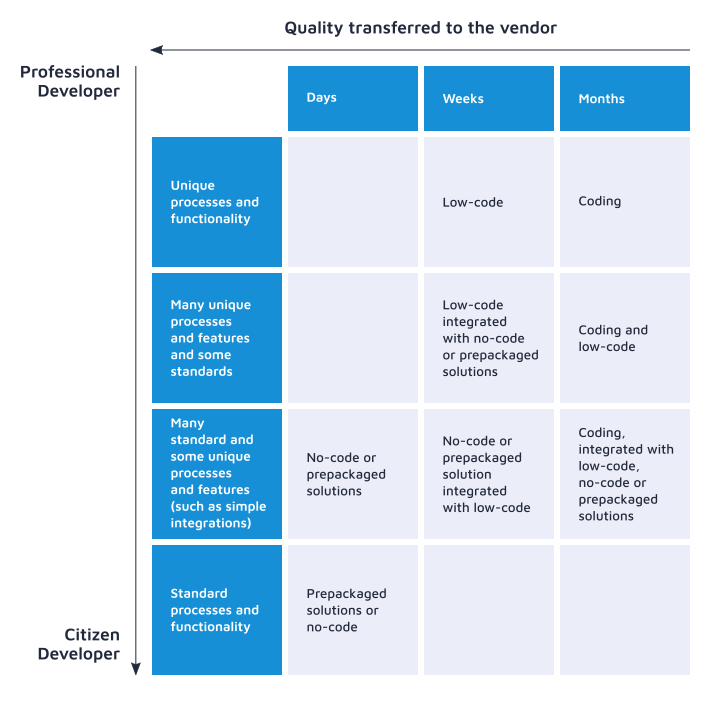Prepackaged solutions, No-Code, Low-Code or Coding?

The trade-off between innovation, development times and quality
In the phase of choosing which technology to use to transform processes digitally, it is necessary to consider the trade-off between innovation and implementation times.
In fact, when it is necessary to create new digital processes, it is not possible to refer to prepackaged ready-to-use solutions on the market, which contain standard and non-customizable features based on the company’s business model.
Innovation, on the other hand, is synonymous with uniqueness of functionality; therefore, in the digital environment, it entails coding customized code and, consequently, much more important development time.
The speed of implementation, on the other hand, must be compared to the quality of the solutions created: when prepackaged solutions or No-Code and Low-Code technologies are used, in fact, the control of solutions’ code quality is transferred to the vendors, which they must carry out independently when it is coded.
For these reasons, an analysis of the available technologies is necessary to obtain the solutions that bring the company digital innovation quickly and with better quality.
Questions to ask when choosing technologies
Those responsible for digital transformation today have different technologies available depending on the resources, needs and times to implement digital solutions. From ready-made market solutions to no-code and low-code to traditional coding.
From our experience, in the choice phase, the questions that a company that wants to transform processes should ask itself are
- Are the processes to be digitalized comparable to standards already on the market, or are they unique and an element of differentiation for the company?
- Who checks the quality of the solutions created? What does quality control cost?
- How long does it take to implement digital solutions?
- Are the resources and skills necessary for the internal development of digital processes and functions present in the company?
The answers and the possible choices
We summarize the answers to the questions in the following diagram, where we see that Low-Code and Coding are suitable for creating innovative processes and functionalities because in ready-made vertical solutions and no-code platforms, only small adaptations and standardized process configurations are possible.
With Low-Code, you get to detail the UX, the processes and the business logics. With Coding, it is also possible to choose the technologies and architecture with which the solutions are created.
As the degree of development transferred to the vendor increases, the created solutions’ quality increases. In this case, there is a dichotomy between make and buy, evaluating internal or market costs and the possibilities that outsourcing offers to focus resources on other activities.
Production time range from months with coding to weeks with low-code to days with no-code and prepackaged configurable vertical SaaS.
Finally, when evaluating the necessary resources in the company, it is necessary to choose whether to lean toward Citizen Developers, more suited to ready-made and No-Code solutions, or Professional Developers, necessary for development with Low-Code and traditional Coding.

reworked from https://dzone.com/articles/low-code-no-code-business-strategies
We can outline the choice of technology to be adopted in the following matrix, knowing that there are many different possibilities in the needs of digitization, so the technologies are not mutually exclusive but can be integrated to supply the company’s needs better. For example, an online portal to offer customers customized services (such as analysis, documents, reports and many more) can be divided into two solutions: the showcase site, which is created with a prepackaged market CMS, and the portal that is accessed by the customer is developed with Low-Code.

Low-Code: the best relationship between innovation, speed and quality of development for enterprise solutions
Our analysis shows that low code allows you to create innovative enterprise-level solutions in a few weeks, with the vendor’s guarantee of the code quality automatically generated, but leaves the control of processes and functions to professional developers.
In fact, if market solutions bring the company digitalization but not innovation, No-Code is suitable for creating simple, tactical and non-strategic applications at the company level, as traditional Coding requires time and resources that increase the risk of losing opportunities for companies and of the loss of quality due to time to market and speed of innovation of competitors who instead use low-code systems.
But Low-Code technology is not only one useful for saving time and resources; in fact, we propose an integrated approach in choosing which system to use. In this way, it is possible to link tactical and strategic solutions, front office and back office, standard and innovative, using the various systems where most necessary to obtain the best mix between uniqueness, time to market and quality of the solutions.
Latest Stories
CIO priority for 2026: boosting productivity, including Low-Code
Customised AI in 1 Month with Low-Code: AI Mind by OriginalSkills
WebRatio Platform 9.3.0: more autonomy, more productivity, more control – and a new look for your apps
Tag
AllArtificial Intelligence - AI
BPA Development
BPM Software
Customer
Digital Transformation
Distribution & Retail
Energy & Utilities
Enterprise Applications
Finance & Insurance
IoT
LinkedIn Live
Low-code
Manufacturing
Mobile Development
Modernization
Partner
Shadow IT
Travel & Transportation
Web Development
WebRatio Platform